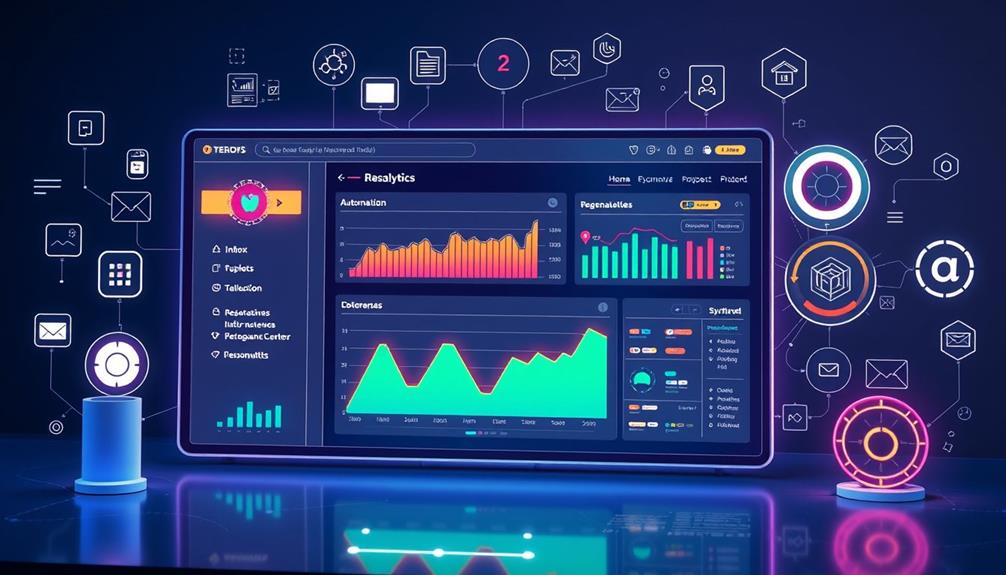Predictive analytics in email marketing helps you anticipate subscriber behavior by analyzing past interactions and engagement patterns. This allows you to segment your audience effectively, sending targeted content that resonates with their preferences. By understanding which subscribers are at risk of churning, you can create retention strategies that foster loyalty and increase lifetime value. Predictive tools can even optimize send times and personalize content, boosting open and click-through rates. As you explore further, you'll find even more strategies to enhance your email marketing effectiveness.
Key Takeaways
- Predictive analytics enhances email marketing by forecasting subscriber behavior, leading to more targeted and effective campaigns.
- Analyzing historical engagement data helps identify patterns, predicting future open and click rates.
- Segmentation based on behavior and preferences improves relevance, reducing unsubscribe rates and boosting engagement.
- Churn prediction models enable marketers to identify at-risk subscribers and implement proactive retention strategies.
- Real-time analytics allow for immediate adjustments to campaigns, optimizing send times and content based on current subscriber behavior.
Importance of Predictive Analytics

In today's crowded inboxes, where the average open rate for email marketing hovers below 15%, leveraging predictive analytics is more vital than ever. By utilizing predictive analytics, you can enhance your email marketing strategies and greatly improve engagement rates. This powerful tool allows you to predict customer behavior, tailoring your campaigns to meet subscribers' needs and preferences.
With high unsubscribe rates due to irrelevant content, it's essential to create targeted and relevant emails. Predictive analytics helps you segment your audience effectively, ensuring that the right message reaches the right person at the right time. When you personalize your emails based on predictive insights, you not only reduce churn but also maximize subscriber lifetime value, estimated at $20 or more.
Consider the impact: a targeted campaign can generate considerable sales compared to a generic approach. For instance, one campaign achieved 842 sales from 273,334 subscribers, while a control group of 20,000 garnered just three sales.
Understanding Subscriber Behavior
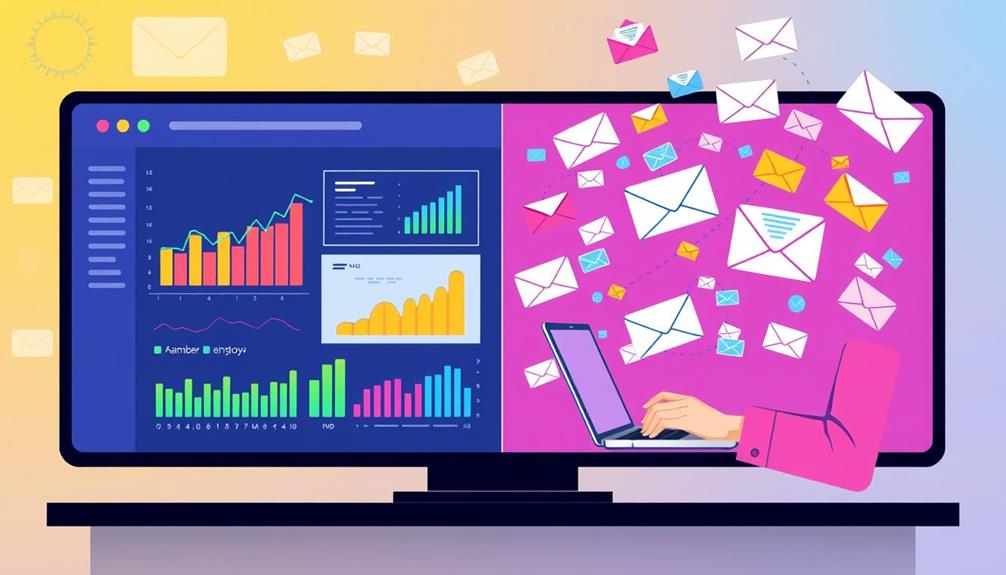
Understanding subscriber behavior is key to crafting successful email marketing campaigns. By leveraging predictive analytics, you can analyze historical data like past open and click rates to forecast how your subscribers are likely to act in the future. This insight allows you to tailor your messaging, making it more relevant and engaging.
Additionally, employing effective email marketing strategies can further enhance your approach by ensuring your content resonates with your audience's interests.
Focusing on engagement metrics helps you identify patterns in subscriber behavior, so you can spot who's most likely to engage with specific offers. With the average email open rate below 15%, honing in on these behaviors is essential for improving your targeting and minimizing inbox clutter.
Predictive analytics also enables you to pinpoint subscribers at risk of churning by evaluating their engagement levels. This allows you to implement timely retention strategies, ensuring you keep your audience engaged.
Additionally, tailoring email content based on predicted preferences can lead to significant improvements in click-through rates. Targeted campaigns can achieve conversion rates as high as 0.31%, compared to a mere 0.02% for generic outreach.
Techniques for Data Segmentation
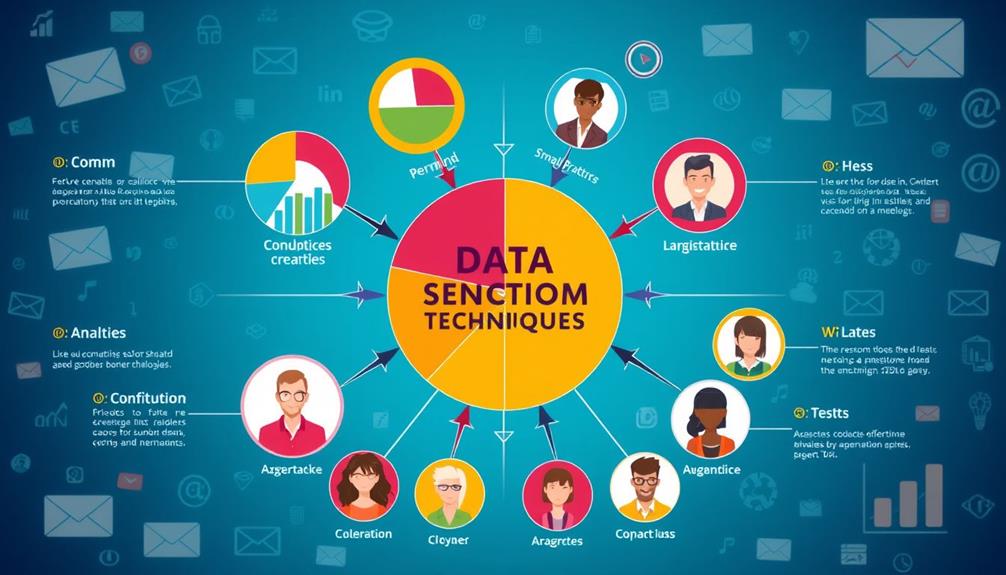
Effective data segmentation can transform your email marketing efforts by allowing you to connect with subscribers on a more personal level. By dividing your audience into distinct groups based on shared characteristics like demographics and engagement levels, you can create targeted messaging that resonates with each segment.
Predictive analytics plays an essential role here, as it helps you identify specific subscriber behavior patterns that indicate who's likely to respond to particular offers. Additionally, utilizing top platforms for earning can offer insights into how different segments engage with content, providing valuable context for your campaigns.
Using advanced segmentation techniques, such as clustering algorithms, can uncover hidden patterns in your data. This means you can tailor your email campaigns to cater to unique audience preferences, ensuring that the right message reaches the right people at the right time.
For example, a campaign that targeted 273,334 subscribers using predictive analytics achieved an impressive engagement rate of 0.31%, considerably higher than the 0.02% from a control group.
Effective segmentation strategies not only enhance the relevance of your emails but also improve performance metrics like open and click-through rates. Plus, by reducing unsubscribe rates, you contribute to overall revenue growth and higher customer retention, making your email marketing efforts much more impactful.
Predicting Subscriber Churn

To keep your email list healthy, you need to identify subscribers who are at risk of churning. By analyzing their engagement patterns and demographics, you can develop targeted retention strategies that really work.
This approach not only helps maintain your subscriber base but also boosts your overall revenue.
Additionally, understanding the emotional impact of loss, similar to the emotional impact of divorce, can guide your communication strategies to better resonate with subscribers during challenging times.
Identifying At-Risk Subscribers
Identifying at-risk subscribers is essential for any email marketing strategy, as it allows you to take proactive steps to retain valuable customers. Predictive analytics plays a vital role in this process by analyzing demographic and behavioral data to pinpoint those who are likely to churn.
By leveraging techniques like the Chi-squared Automatic Interaction Detector and multiple regression analysis, you can assess churn likelihood and gain insights into subscriber behavior. As the demand for data-driven decision-making increases, AI software engineer jobs are becoming more prevalent, emphasizing the importance of analytics in marketing.
You'll want to focus on subscribers who engage less frequently or show declining interaction patterns, as these individuals are flagged as at-risk subscribers. This identification process enables you to implement targeted interventions aimed at re-engaging them before they decide to unsubscribe.
Calculating the lifetime value of your subscribers further helps prioritize high-value individuals for personalized retention offers. This not only enhances your overall campaign effectiveness but also greatly reduces churn rates.
With targeted interventions based on churn likelihood, you can improve subscriber retention and increase the lifetime value of your subscribers, ultimately leading to a more successful email marketing strategy.
Retention Strategy Development
A robust retention strategy hinges on accurately predicting subscriber churn, allowing you to act before valuable customers leave. By leveraging predictive analytics, you can analyze demographic and customer behaviors to identify subscribers at risk of churn. Techniques like the Chi-squared Automatic Interaction Detector or multiple regressions can help assess churn risk, enabling you to prioritize your focus on at-risk subscribers.
Understanding the importance of a budget in managing resources can also play an essential role in developing effective retention strategies.
Utilizing a revenue matrix, you can classify subscribers based on their churn risk, directing your retention strategies towards high-value individuals. Understanding that the estimated lifetime value of a subscriber is $29.97 over three years, you can craft tailored retention offers that enhance engagement with these high-value customers.
Moreover, continuous analysis of subscriber behavior through predictive modeling allows for timely interventions. This not only improves customer retention rates but also reduces overall churn.
Calculating Subscriber Lifetime Value
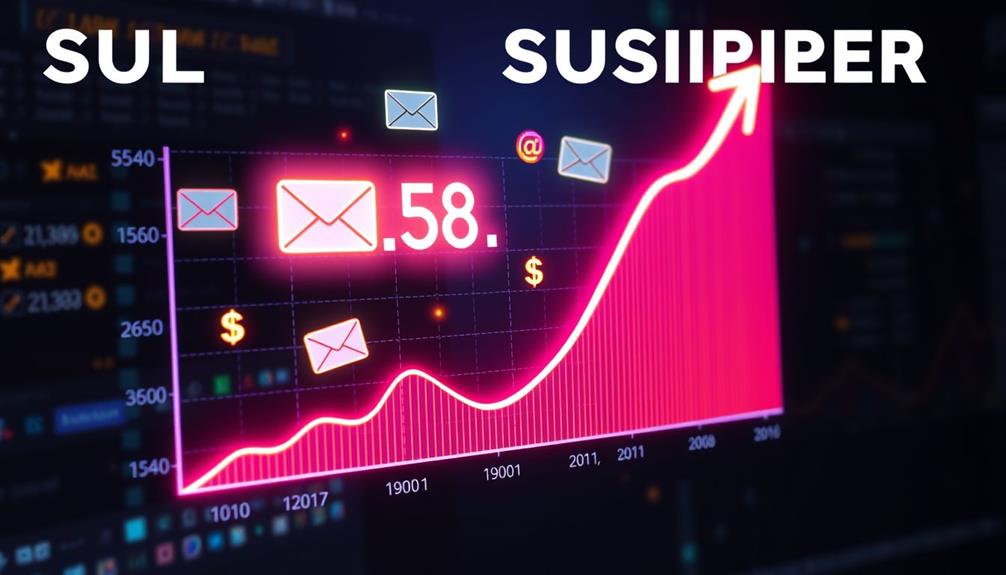
Understanding subscriber lifetime value (LTV) is essential for maximizing your email marketing efforts. By calculating LTV, you can identify which subscribers are worth the most to your business and tailor your retention strategies accordingly.
For instance, just as businesses in the precious metal investment sector focus on understanding their customer base to drive engagement, you can apply similar methods to analyze your subscribers.
Let's explore the various methods to calculate LTV and how to leverage this information for better engagement.
Importance of Lifetime Value
Subscriber lifetime value (SLV) plays an essential role in shaping your email marketing strategy, as it quantifies the potential revenue each subscriber can generate over time. Understanding SLV helps you prioritize retention strategies for high-value subscribers, ensuring your campaigns meet their needs and preferences.
| Key Metric | Importance |
|---|---|
| Average Purchase Value | Determines revenue per transaction |
| Purchases Per Year | Indicates frequency of customer purchases |
| Average Customer Lifespan | Reflects how long subscribers stay engaged |
Calculation Methods Explained
Calculating subscriber lifetime value (SLV) is essential for optimizing your email marketing efforts. It helps you estimate the average revenue generated by a subscriber over their entire relationship with your brand, typically measured in years.
To calculate SLV, you'll want to evaluate key factors like average purchase value, purchase frequency, and retention rate. This approach provides a holistic view of a subscriber's financial contribution, which aligns with content relevance and authority in your marketing strategies.
On average, a subscriber's lifetime value is around $29.97 over three years. Knowing this figure allows you to prioritize retention strategies for high-value subscribers, ensuring you focus your resources effectively.
By segmenting subscribers based on their calculated SLV, you can tailor your marketing efforts to enhance engagement metrics and create targeted retention offers.
Understanding SLV empowers you to make data-driven decisions about how much to invest in acquiring and retaining subscribers. This not only boosts the effectiveness of your email marketing campaigns but also reduces churn by ensuring your strategies are aligned with subscriber value.
Ultimately, calculating SLV is a critical step in maximizing the return on your marketing investments.
Strategies for Retention
To enhance retention efforts, it's important to leverage the insights gained from calculating subscriber lifetime value (SLV). Understanding SLV helps you estimate the total revenue a subscriber will generate, allowing you to prioritize high-value segments effectively.
With an average SLV of $29.97 over three years, focusing on these segments can greatly boost your retention strategies. Additionally, investing in personalized retention offers becomes justifiable when you know the potential value of your subscribers, much like how daily cranberry juice consumption can lead to overall health benefits.
Using predictive analytics, you can assess the likelihood of subscriber churn by analyzing demographic and behavioral data. This enables you to identify at-risk subscribers and implement proactive retention efforts tailored to their needs.
By regularly updating SLV calculations with real-time engagement and transactional data, you can adapt your strategies to optimize lifetime value. Investing in personalized retention offers becomes justifiable when you know the potential value of your subscribers.
Allocate your resources efficiently toward high-value segments to maximize returns and reduce churn rates. By employing these targeted retention strategies, you can foster deeper customer loyalty, ensuring that your subscribers remain engaged and profitable over time.
Embrace SLV as a key driver in your retention efforts, and watch your email marketing efficacy soar.
Real-Time Predictive Analytics
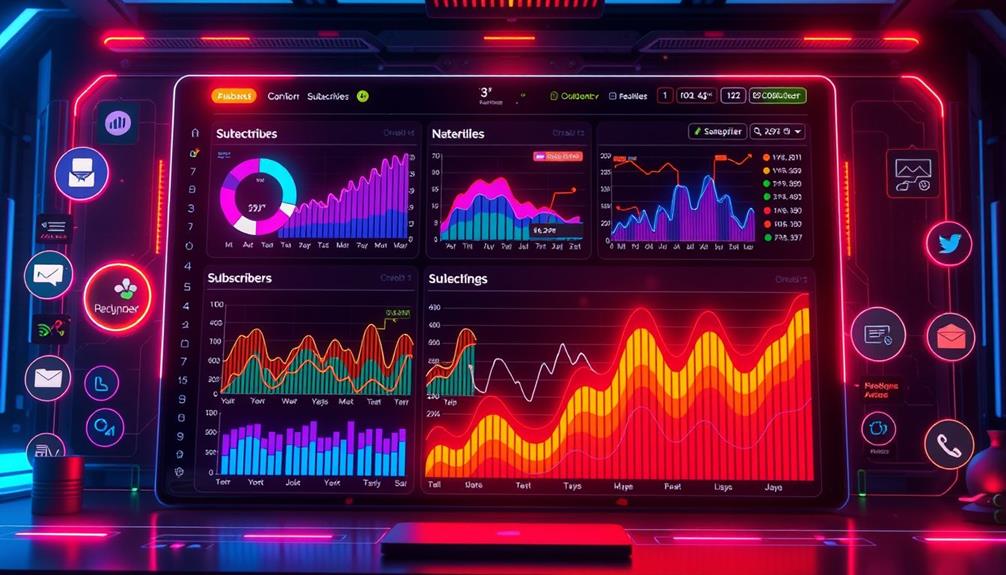
Real-time predictive analytics revolutionizes how marketers engage with their audience by harnessing the power of Edge ML to analyze customer data on-site. This approach allows you to use real-time data to make immediate adjustments to your email campaigns based on the latest subscriber behavior and preferences.
Additionally, incorporating techniques from the music industry, such as creating thematic coherence and understanding audience engagement, can enhance your email strategies. With real-time A/B testing, you can optimize email variations quickly and efficiently, ensuring that your strategies align with current engagement metrics.
By processing data as it comes in, you can pinpoint the best send times for your emails, leading to considerably increased open rates and overall campaign engagement. Furthermore, real-time analytics help identify early signs of subscriber churn, giving you the chance to implement retention strategies before customers disengage.
Utilizing this technology results in a more personalized email experience. By tailoring content to align closely with individual subscriber needs and behaviors, you can drive higher conversion rates. Embracing this uplifting music technology not only enhances your understanding of your audience but also transforms your email marketing efforts into a more dynamic, responsive, and effective strategy.
Implementing AI in Email Campaigns

There's no denying that implementing AI in email campaigns can considerably enhance your marketing efforts. By leveraging predictive analytics and machine learning algorithms, you can analyze customer data to create a robust email marketing strategy that speaks to individual preferences. This not only boosts engagement and conversion rates but also enhances the overall customer experience.
| Feature | Benefits | Impact on Campaigns |
|---|---|---|
| Personalized Content | Tailored messages for each subscriber | Increases open rates by over 20% |
| Churn Prediction | Identifies at-risk subscribers | Reduces unsubscribe rates by up to 30% |
| Dynamic A/B Testing | Real-time adjustments to content | Aligns campaigns with current preferences |
AI allows you to optimize send times and segment your audience effectively. With tools like IBM Watson and Salesforce, you can automate data analysis, gaining actionable insights that drive higher engagement. By integrating AI into your email campaigns, you not only anticipate subscriber behavior but also craft messages that resonate, ensuring your marketing strategy remains ahead of the curve.
Tools for Predictive Analytics

When you're looking to enhance your email marketing strategy, choosing the right predictive analytics tools is essential.
Tools like Google Analytics, IBM Watson, and Salesforce can help you evaluate customer behaviors and optimize your campaigns.
Additionally, incorporating insights from current trends in private equity markets can inform your targeting strategies and improve engagement.
You'll want to assess their effectiveness and features to guarantee they meet your specific marketing needs.
Essential Predictive Analytics Tools
Harnessing the power of predictive analytics can transform your email marketing strategy, allowing you to anticipate subscriber behavior and tailor your campaigns more effectively. Several essential tools can help you do just that.
Google Analytics is a must-have for email marketers. It tracks user behavior after email interactions, offering insights into conversion rates that optimize your strategies.
IBM Watson takes it further with its AI and machine learning capabilities, analyzing customer data to craft personalized marketing strategies that boost engagement.
Salesforce also shines with its predictive analytics tools. They enable you to assess customer lifetime value and forecast subscriber behavior, helping you create targeted email campaigns that improve retention.
Mailchimp comes equipped with built-in predictive analytics, identifying segments of subscribers likely to engage or churn, so you can adjust content accordingly.
Lastly, Adobe Analytics provides insights into customer journeys across channels, revealing the best timing and content for your emails based on user interactions.
Evaluating Tool Effectiveness
Selecting the right predictive analytics tools is essential for maximizing the effectiveness of your email marketing campaigns. To evaluate tool effectiveness, you should focus on key performance indicators (KPIs) that reflect customer behavior and engagement rates. Tools like Google Analytics and Salesforce offer robust features that allow you to analyze and forecast subscriber actions effectively.
Here's a quick comparison of popular tools:
| Tool | Key Features | Best For |
|---|---|---|
| Google Analytics | Website traffic insights, A/B testing | Analyzing engagement |
| IBM Watson | Advanced data analysis, predictive modeling | Forecasting behavior |
| Salesforce | CRM integration, subscriber segmentation | Managing high-value leads |
Continuous Improvement Strategies
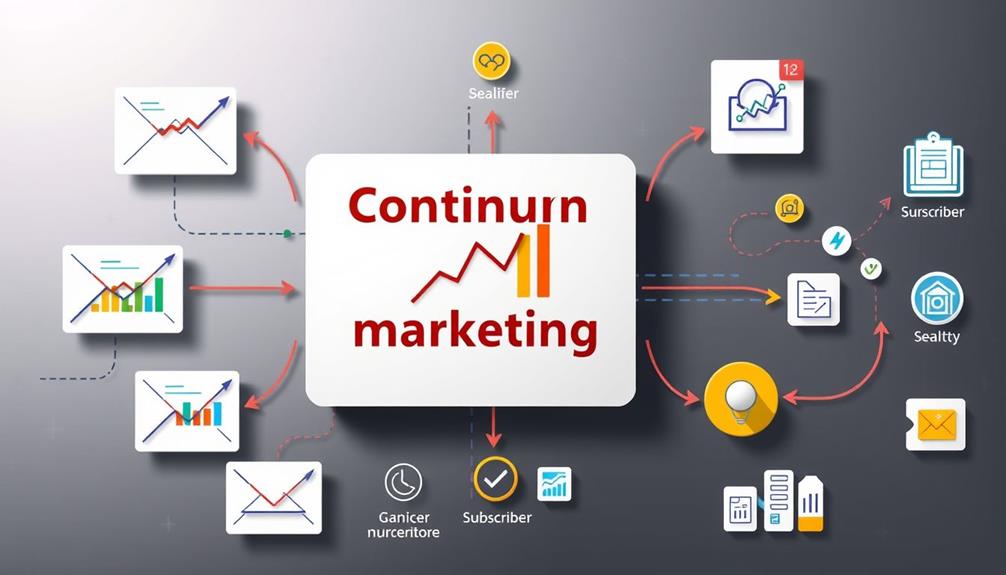
To continuously improve your email marketing efforts, you need to keep a close eye on key performance metrics like open rates, click-through rates, and conversion rates. By regularly monitoring these email engagement metrics, you can identify areas for enhancement.
Implementing A/B testing is vital; it allows you to compare different subject lines, content types, and send times. This data-driven approach refines your email strategies based on subscriber interactions.
Gathering and analyzing customer feedback is essential, too. Insights from surveys or engagement metrics can guide your content creation and improve personalization efforts. Leveraging tools that provide real-time predictive analytics enables you to make immediate adjustments, ensuring your email content aligns with current customer preferences and behaviors.
Moreover, continuously updating your subscriber segments based on their engagement history and relevant data helps maintain relevance. Targeted messaging reaches the most interested audiences, reducing churn and enhancing overall effectiveness.
Case Studies and Examples
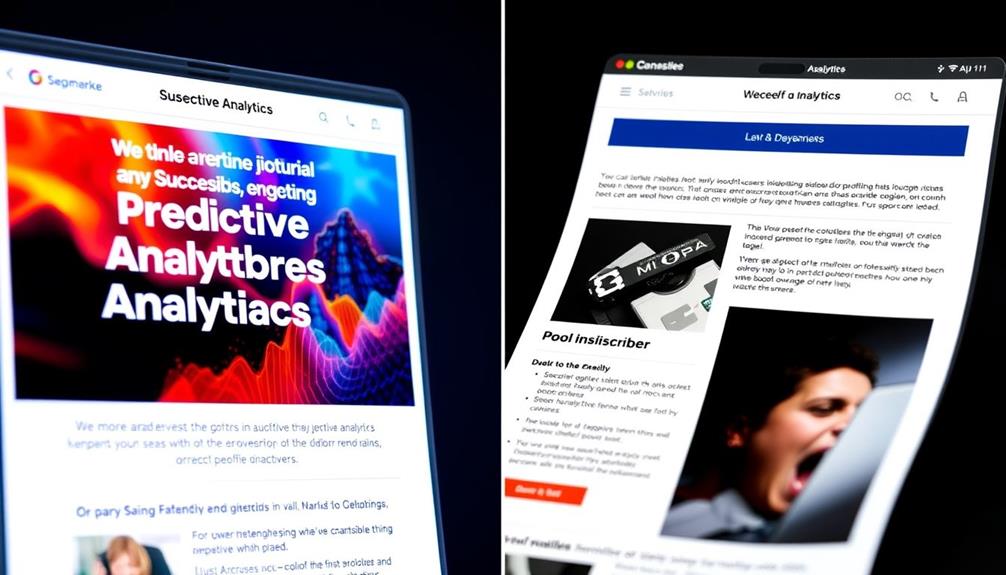
Success in email marketing often hinges on real-world applications and proven strategies. You can draw valuable insights from various case studies that showcase the power of predictive analytics in enhancing targeted email campaigns.
Here are three standout examples that illustrate this:
- A leading retail brand saw a 25% increase in click-through rates by using predictive analytics to craft personalized content for their campaigns.
- An e-commerce company focused on customer segments identified at risk of churning, achieving a 30% reduction in unsubscribe rates through tailored re-engagement efforts.
- A global travel agency utilized predictive modeling, leading to a 40% boost in bookings from targeted promotions based on previous travel behaviors.
These cases demonstrate how understanding subscriber behavior and leveraging predictive analytics can greatly enhance your email marketing effectiveness.
By segmenting your audience and optimizing your strategies, you can improve key metrics like email open rates and overall engagement.
Adopting these methods can transform your approach, ensuring you're not only reaching your audience but resonating with them in a meaningful way.
Frequently Asked Questions
What Is Predictive Analytics for Customer Behavior?
Predictive analytics for customer behavior analyzes historical and real-time data to identify patterns. You can forecast future actions by employing techniques like regression analysis and machine learning, helping you tailor strategies for better engagement and retention.
What Are the Three Techniques Used in Predictive Analytics?
You'll find that regression analysis, classification algorithms, and time series analysis are key techniques in predictive analytics. Each helps you understand patterns, segment audiences, and optimize strategies to enhance engagement and drive conversions effectively.
What Are the Four Primary Aspects of Predictive Analytics?
Think of a crystal ball revealing insights. The four primary aspects of predictive analytics are data collection, analysis, modeling, and interpretation. These elements help you forecast behavior, guiding your strategies effectively and enhancing decision-making.
What Are the 5 Steps in the Predictive Analytics Process Cycle?
To navigate the predictive analytics process, you'll collect relevant data, prepare it for analysis, select and develop appropriate models, evaluate their effectiveness, and finally deploy and monitor them for continuous improvement in your campaigns.
Conclusion
Incorporating predictive analytics in your email marketing can transform your approach from reactive to proactive. While you may currently rely on past data to inform decisions, harnessing AI allows you to anticipate subscriber behavior with precision. This shift not only enhances customer engagement but also minimizes churn and maximizes lifetime value. By continuously refining your strategies, you'll not only keep pace with evolving trends but also set the standard in your industry. Embrace the future; your subscribers will thank you.



